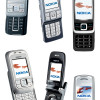Motorola & Nokia Summer Kickoff
The E895 will be the first phone to feature Motorola's next generation OS. This is the OS that will eventually be in all of Moto's phones, at least the non-smartphone variety. It is based on Linux and features tight Java integration. Although it runs Linux, this is not necessarily a smartphone nor is it inscrutably geeky. Like TiVo, which is also based on Linux, the power beneath is hidden by a simple, clear menu system.
All opinions and pictures that follow are of an OS still under development by Motorola. Nothing you see here is final. Some aspects of both design and features can and will change before the E895 launches later this year.
Home Screen and Menus
The home screen features many of the same elements as the current OS. In fact, it looks almost exactly the same until you get down to the softkeys. Gone are the programmable softkeys and third "menu" button of old. They are now replaced with an "options" key, which brings up a shortcut menu similar to Sony Ericsson's "more" key, and a "main menu" key. (Note, this is not the final font, and main menu will fit inside the right button when the E895 is launched.)
The new options menu contains shortcuts to common tasks hidden in the settings menu as expected, but it also has shortcuts to common application functions (like create new text message) as well. This is especially helpful since Motorola has only allowed shortcuts to applications, not specific menu items, in the past.
It's still too early in the development process for us to form final opinions on the new applications - we couldn't really give them a thorough shakedown. However one thing that was easily spotted was that the new applications have a very Nokia Series 60 look and feel to them. It was most obvious in the contacts and messaging applications, where both the look and the item names were similar.
We got to see a few big improvements to the new applications, and Motorola has told us about even more. The contacts application is finally up to snuff. It has far more fields for information, and is finally searchable beyond the first letter of the entry name. The messaging application follows suit behind Sony Ericsson and Kyocera and makes the five most commonly used numbers available on the SMS address screen.
Also, though it wasn't activated on the phone we tested, there is finally an option to auto-save pictures in the camera application instead of them being deleted unless explicitly saved. Despite this welcome addition, as well as many new options, the camera application still isn't perfect. It only displayed a tiny thumbnail on the picture review screen, negating any advantage offered by the huge display.
Motorola is using Opera 7.0 as their browser in the new OS, at least in the E895. Another HTML capable browser may be chosen later for other handsets. Finally, Motorola has included an OTA (over-the-air) software update option on the phone, something the company has been talking up and it's nice to see them committing to.














 Nokia Nseries Launch
Nokia Nseries Launch
 Nokia Raises Series 40 To New Heights
Nokia Raises Series 40 To New Heights
 Samsung Refreshes Galaxy S Series with S Pen, New Cameras
Samsung Refreshes Galaxy S Series with S Pen, New Cameras
 iPhone 15 Series Goes All-In on USB-C and Dynamic Island
iPhone 15 Series Goes All-In on USB-C and Dynamic Island
 Nokia N90
Nokia N90
 Nokia 6270
Nokia 6270
 Nokia 6265i
Nokia 6265i

